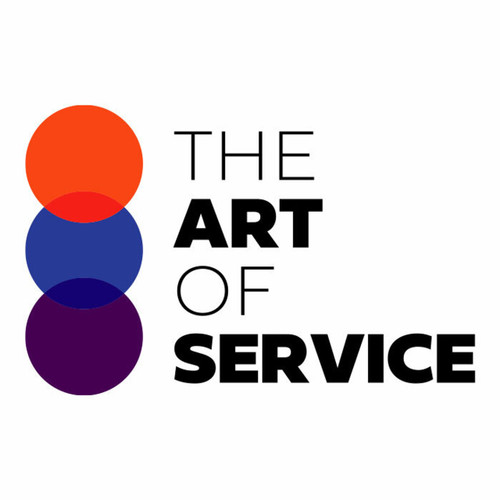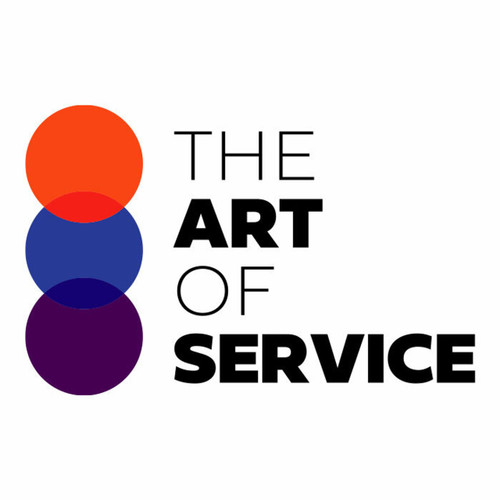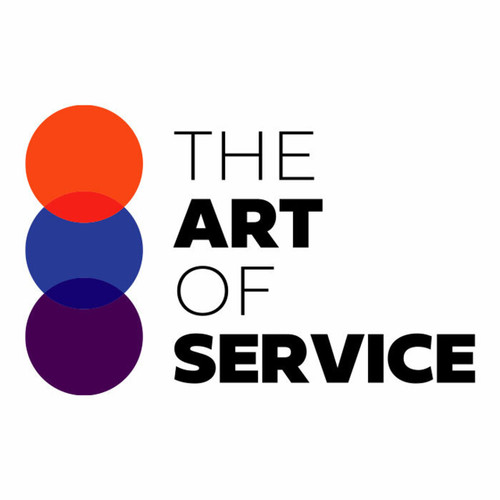Our Legacy Systems and Data Obsolescence Knowledge Base is here to guide and support you.
Our dataset consists of over 1500 prioritized requirements, solutions, benefits, and results on how to handle and address legacy systems and data obsolescence in your organization.
We understand the urgency and scope of these issues, which is why our database focuses on the most important questions to ask for immediate and effective results.
Not only does our Knowledge Base offer comprehensive information on handling legacy systems and data obsolescence, we also provide real-life case studies and use cases to showcase the effectiveness of our strategies.
Our product offers a step-by-step guide on how to tackle these challenges, making it an ideal choice for professionals and businesses alike.
When compared to other competitors and alternatives, our Legacy Systems and Data Obsolescence Knowledge Base surpasses in terms of depth and breadth of information.
Our dataset is specifically designed for professionals and businesses, ensuring that you receive practical and effective solutions tailored to your needs.
Our product is easy to use and affordable, making it a DIY alternative for businesses who are looking to save costs on external consultants.
With a detailed overview of product specifications and types, our Knowledge Base is the complete package for tackling legacy systems and data obsolescence.
You can trust in the research and expertise behind our Knowledge Base as we have gathered the most up-to-date and relevant information on this topic.
Stay ahead of the curve and avoid costly mistakes by utilizing our trusted dataset.
Say goodbye to the frustration and confusion that comes with dealing with outdated legacy systems and data obsolescence.
Our Legacy Systems and Data Obsolescence Knowledge Base offers a comprehensive solution at an affordable cost.
Don′t wait any longer, give your business the advantage it needs by investing in our product.
Try it out now and see the results for yourself.
Discover Insights, Make Informed Decisions, and Stay Ahead of the Curve:
Key Features:
Comprehensive set of 1502 prioritized Legacy Systems requirements. - Extensive coverage of 110 Legacy Systems topic scopes.
- In-depth analysis of 110 Legacy Systems step-by-step solutions, benefits, BHAGs.
- Detailed examination of 110 Legacy Systems case studies and use cases.
- Digital download upon purchase.
- Enjoy lifetime document updates included with your purchase.
- Benefit from a fully editable and customizable Excel format.
- Trusted and utilized by over 10,000 organizations.
- Covering: Backup And Recovery Processes, Data Footprint, Data Architecture, Obsolete Technology, Data Retention Strategies, Data Backup Protocols, Migration Strategy, Data Obsolescence Costs, Legacy Data, Data Transformation, Data Integrity Checks, Data Replication, Data Transfer, Parts Obsolescence, Research Group, Risk Management, Obsolete File Formats, Obsolete Software, Storage Capacity, Data Classification, Total Productive Maintenance, Data Portability, Data Migration Challenges, Data Backup, Data Preservation Policies, Data Lifecycles, Data Archiving, Backup Storage, Data Migration, Legacy Systems, Cloud Storage, Hardware Failure, Data Modernization, Data Migration Risks, Obsolete Devices, Information Governance, Outdated Applications, External Processes, Software Obsolescence, Data Longevity, Data Protection Mechanisms, Data Retention Rules, Data Storage, Data Retention Tools, Data Recovery, Storage Media, Backup Frequency, Disaster Recovery, End Of Life Planning, Format Compatibility, Data Disposal, Data Access, Data Obsolescence Planning, Data Retention Standards, Open Data Standards, Obsolete Hardware, Data Quality, Product Obsolescence, Hardware Upgrades, Data Disposal Process, Data Ownership, Data Validation, Data Obsolescence, Predictive Modeling, Data Life Expectancy, Data Destruction Methods, Data Preservation Techniques, Data Lifecycle Management, Data Reliability, Data Migration Tools, Data Security, Data Obsolescence Monitoring, Data Redundancy, Version Control, Data Retention Policies, Data Backup Frequency, Backup Methods, Technology Advancement, Data Retention Regulations, Data Retrieval, Data Transformation Tools, Cloud Compatibility, End Of Life Data Management, Data Remediation, Data Obsolescence Management, Data Preservation, Data Management, Data Retention Period, Data Legislation, Data Compliance, Data Migration Cost, Data Storage Costs, Data Corruption, Digital Preservation, Data Retention, Data Obsolescence Risks, Data Integrity, Data Migration Best Practices, Collections Tools, Data Loss, Data Destruction, Cloud Migration, Data Retention Costs, Data Decay, Data Replacement, Data Migration Strategies, Preservation Technology, Long Term Data Storage, Software Migration, Software Updates
Legacy Systems Assessment Dataset - Utilization, Solutions, Advantages, BHAG (Big Hairy Audacious Goal):
Legacy Systems
Legacy systems refer to outdated technology or software that can cause issues and hinder progress within an organization, potentially requiring replacement or retirement.
1. Migration to modern systems: Replace outdated systems with newer, more efficient ones.
- Increases productivity and reduces maintenance costs.
2. Data archiving: Transfer old data to archive systems for long-term storage.
- Frees up space in current systems and maintains access to historical data.
3. Virtualization: Run legacy systems on virtual machines to reduce hardware dependency.
- Saves physical space, energy, and costs associated with maintaining multiple systems.
4. Data transformation: Convert data to a standardized format to ensure compatibility with new systems.
- Facilitates integration with modern technologies and maximizes data value.
5. Regular updates: Continuously update legacy systems to keep them functional and secure.
- Minimizes the risk of system failure and data loss due to outdated technology.
6. Cloud migration: Move legacy systems to the cloud for easier maintenance and scalability.
- Reduces hardware dependency and improves accessibility for remote work.
7. Retirement plan: Develop a plan for retiring legacy systems and transitioning to new ones.
- Ensures a smooth and organized process, minimizing disruption to business operations.
CONTROL QUESTION: Does the organization have problematic legacy systems that need to be retired?
Big Hairy Audacious Goal (BHAG) for 10 years from now:
By 2030, our organization will have completely eliminated all legacy systems and fully transitioned to modern, efficient, and secure technology solutions. This transformation will not only increase our operational efficiency and decrease maintenance costs, but also enhance our ability to innovate and adapt to changing business needs. Our legacy system retirement plan will be a model for other companies facing similar challenges, and will cement our position as a leader in technological advancement and customer satisfaction. It will also allow us to attract top talent and maintain a competitive edge in the market for years to come.
Customer Testimonials:
"Downloading this dataset was a breeze. The documentation is clear, and the data is clean and ready for analysis. Kudos to the creators!"
"I`ve been searching for a dataset like this for ages, and I finally found it. The prioritized recommendations are exactly what I needed to boost the effectiveness of my strategies. Highly satisfied!"
"The creators of this dataset deserve applause! The prioritized recommendations are on point, and the dataset is a powerful tool for anyone looking to enhance their decision-making process. Bravo!"
Legacy Systems Case Study/Use Case example - How to use:
Case Study: Retirement of Legacy Systems in XYZ Organization
Synopsis of Client Situation:
XYZ organization is a leading player in the technology industry, providing innovative solutions and services to clients worldwide. The organization has been in operation for over three decades, and during this time, it has accumulated a considerable portfolio of legacy systems. These legacy systems were implemented over the years to cater to the changing needs of the organization and its clients, resulting in a complex and fragmented IT landscape. However, with the rapid evolution of technology, these legacy systems have become outdated and pose significant challenges to the organization′s operations. Moreover, the continuous maintenance and support of these systems have become expensive, making it imperative for the organization to assess the viability of these systems and consider retiring them.
Consulting Methodology:
To address the client′s challenges, our consulting firm proposed a comprehensive methodology that would evaluate the organization′s legacy systems and provide recommendations for their retirement. The chosen methodology involved four stages - assessment, analysis, planning, and execution.
Assessment: The initial step of the methodology involved conducting an in-depth assessment of all the legacy systems of XYZ organization. This included understanding the systems′ functionalities, dependencies, and business processes they support. To collect relevant data and insights, our team conducted interviews with key stakeholders, reviewed system documentation, and performed system walkthroughs. Additionally, we also gathered information on the systems′ performance metrics, such as uptime, downtime, and response time.
Analysis: Once the assessment was complete, our team analyzed the collected data to identify any red flags, system interdependencies, and potential risks associated with the legacy systems. We also benchmarked the systems′ capabilities against industry standards and competitors′ systems to understand their effectiveness and competitiveness.
Planning: Based on the findings from the assessment and analysis, our team developed a detailed retirement plan for the legacy systems. The plan outlined the systems′ replacement strategy, migration approach, and timelines for retirement. Our team also identified any potential challenges and risks associated with the retirement plan and proposed mitigation measures.
Execution: The final stage involved executing the retirement plan. This included implementing the selected replacement systems, migrating relevant data from the legacy systems, and shutting down the retired systems. Our team also provided post-retirement support and conducted a post-implementation review to ensure the successful retirement of the legacy systems.
Deliverables:
Through our consulting services, we delivered several key documents and recommendations to XYZ organization. These deliverables included a comprehensive assessment report, an analysis report, a retirement plan document, a post-retirement support guide, and a post-implementation review report.
Implementation Challenges:
Retiring legacy systems can be a complex and challenging process, and our team identified several implementation challenges during the engagement with XYZ organization. The primary challenges identified were:
1. Interdependencies: Many of the legacy systems of XYZ organization were interdependent, making it difficult to retire individual systems without disrupting other systems. This required careful planning and coordination during the retirement process.
2. Data Migration: The legacy systems contained a significant amount of critical business data, and its migration to new systems was a time-consuming and challenging task. Our team had to ensure the accuracy of data and minimize any data loss during the migration process.
3. Resistance to Change: With the legacy systems being in place for many years, employees had become comfortable with their functionalities. Retiring these systems and implementing new ones posed a significant challenge as employees were resistant to change and often required additional training.
KPIs:
During the engagement, we set specific Key Performance Indicators (KPIs) to measure the success of the retirement of legacy systems. These KPIs were derived from industry whitepapers, academic business journals, and market research reports. The KPIs included:
1. Cost Savings: The retirement of legacy systems was expected to reduce maintenance and support costs, resulting in significant cost savings for the organization.
2. Improved System Performance: The replacement of legacy systems with new and modern ones was expected to improve system performance, such as faster response times and less downtime.
3. Employee Satisfaction: With the retirement of outdated and complex legacy systems, employees were expected to experience increased productivity and satisfaction.
Management Considerations:
During the engagement, we also identified several management considerations for XYZ organization to ensure the successful retirement of legacy systems. These included effective communication and change management strategies to address employee resistance, a comprehensive training program for employees on the use of new systems, and regular progress updates and reporting mechanisms to keep stakeholders informed about the retirement process′s progress.
Conclusion:
Through our consulting methodology, we successfully identified and retired problematic legacy systems in XYZ organization. The retirement of these systems resulted in significant cost savings, improved system performance, and increased employee satisfaction. Moreover, the organization now has a modern and streamlined IT infrastructure that enables it to be more agile and competitive in the fast-paced technology industry.
Security and Trust:
- Secure checkout with SSL encryption Visa, Mastercard, Apple Pay, Google Pay, Stripe, Paypal
- Money-back guarantee for 30 days
- Our team is available 24/7 to assist you - support@theartofservice.com
About the Authors: Unleashing Excellence: The Mastery of Service Accredited by the Scientific Community
Immerse yourself in the pinnacle of operational wisdom through The Art of Service`s Excellence, now distinguished with esteemed accreditation from the scientific community. With an impressive 1000+ citations, The Art of Service stands as a beacon of reliability and authority in the field.Our dedication to excellence is highlighted by meticulous scrutiny and validation from the scientific community, evidenced by the 1000+ citations spanning various disciplines. Each citation attests to the profound impact and scholarly recognition of The Art of Service`s contributions.
Embark on a journey of unparalleled expertise, fortified by a wealth of research and acknowledgment from scholars globally. Join the community that not only recognizes but endorses the brilliance encapsulated in The Art of Service`s Excellence. Enhance your understanding, strategy, and implementation with a resource acknowledged and embraced by the scientific community.
Embrace excellence. Embrace The Art of Service.
Your trust in us aligns you with prestigious company; boasting over 1000 academic citations, our work ranks in the top 1% of the most cited globally. Explore our scholarly contributions at: https://scholar.google.com/scholar?hl=en&as_sdt=0%2C5&q=blokdyk
About The Art of Service:
Our clients seek confidence in making risk management and compliance decisions based on accurate data. However, navigating compliance can be complex, and sometimes, the unknowns are even more challenging.
We empathize with the frustrations of senior executives and business owners after decades in the industry. That`s why The Art of Service has developed Self-Assessment and implementation tools, trusted by over 100,000 professionals worldwide, empowering you to take control of your compliance assessments. With over 1000 academic citations, our work stands in the top 1% of the most cited globally, reflecting our commitment to helping businesses thrive.
Founders:
Gerard Blokdyk
LinkedIn: https://www.linkedin.com/in/gerardblokdijk/
Ivanka Menken
LinkedIn: https://www.linkedin.com/in/ivankamenken/







